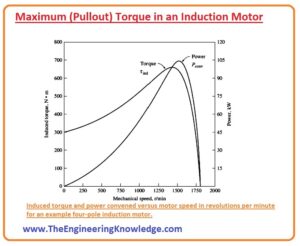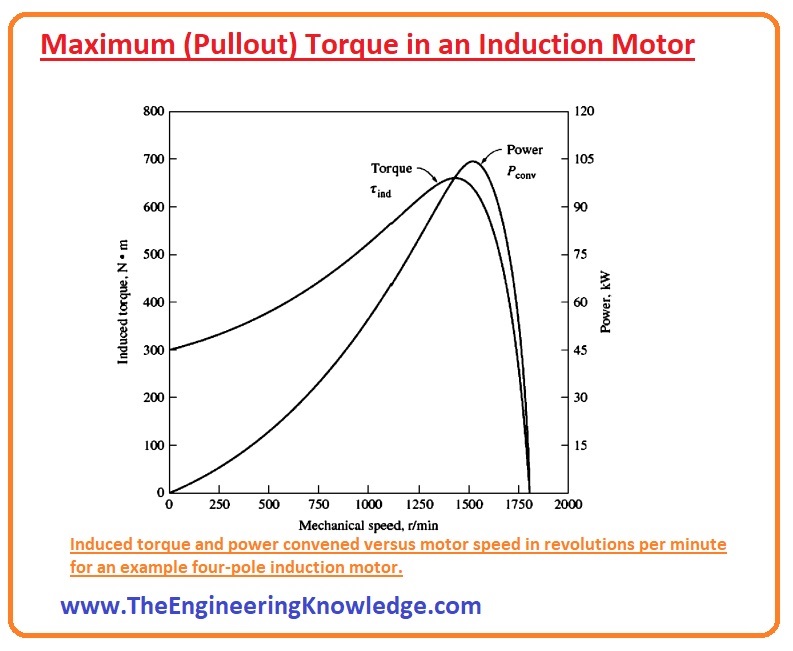 Hello friends, I hope all of you are doing great. In today’s tutorial, we are gonna have a look at the Maximum (Pullout) Torque in an Induction Motor. The maximum or pull-out torque of the three-phase induction motor three-phase induction motor is the extremely bearable torque that the motor can produce without any sudden decrease in its regular speed but for a short time interval. If the motor stays working at its maximum or pullout torque, it will produce serious damage to the rotor of the motor, and in conclusion, the speed of the motor will steadily slow down and the motor stops to work.
Hello friends, I hope all of you are doing great. In today’s tutorial, we are gonna have a look at the Maximum (Pullout) Torque in an Induction Motor. The maximum or pull-out torque of the three-phase induction motor three-phase induction motor is the extremely bearable torque that the motor can produce without any sudden decrease in its regular speed but for a short time interval. If the motor stays working at its maximum or pullout torque, it will produce serious damage to the rotor of the motor, and in conclusion, the speed of the motor will steadily slow down and the motor stops to work.
In today’s post, we will have a look at how torque is produced in the motor and its facts. So, let’s get started with the What is the Maximum (Pullout) Torque in an Induction Motor?
What is the Maximum (Pullout) Torque in an Induction Motor
- As we have discussed in the previous article that the induced torque in the induction motor is found by this equation.
Tind = PAG/Wsync
- The maximum (pullout) probable torque exists when the air-gap power (PAG) is extreme. As the air-gap power (PAG) is equivalent to the power spent in the resistance (R2 /s), the maximum (pullout) induced torque will arise when the power loss by that resistance is extreme.
- As we can see in the given circuit diagram, if we apply the maximum power transformer theorem to this circuit, the maximum power transfer theorem says that the maximum (extreme) power transmitted to the output (in this circuit the output is (R2/s) ) if the impedance (Z) at the output equals to the impedance at the input.
- The correspondent source impedance (Z) in the circuitry is given as.
Zsource = RTH + jXTH + jX2
- Thus, the maximum transfer of power will exit when the given below equation we get.
R2/s = √(R2TH + (XTH + X2)2)
- By resolving this equation, we can find the value of slip at the maximum (pullout) torque of the induction motor which is given below.
Smax = R2/√(R2TH + (XTH + X2)2)
- From this equation, you can note that rotor resistor (R2) exits at the numerator of this equation, thus at maximum (pullout) torque slip (S) of the rotor is directly proportionate to the resistance (R2) of the rotor.
- To find the equation of extreme torque we put the slip equation in the given expression.
Tind= (3VTHR2/s)/ Wsync[(RTH+R2/s)2+(XTH+X2)2]
- This induced torque equation we have determined in the last article which is Derivation of the Induction Motor Induced-Torque Equation you can read it to get this expression.
- After putting the slip equation in the induced torque equation get the expression of the maximum torque.
Tmax = 3V2th/(2wsync[RTH +√(R2TH + (XTH + X2)2)]
- From this equation, we can see that the maximum torque of the induction motor is proportionate to the square of the input voltage (V) and inversely proportionate to the impedance of the rotor and the reactance of the rotor.
- If the motor has a smaller value of reactance, then it will have a large amount of maximum torque.
- From the slip equation, we can observe that the slip at which maximum torque exits is directly proportionate to the resistance of rotor, but from the maximum torque equation we can see that the maximum torque does not depend on the value of the resistance of the rotor.

Effect of varying rotor resistance on the torque-speed characteristic of a wound-rotor induction motor
- The torque-speed characteristic curve for a wound rotor induction motor is drawn in the given diagram.

- Remember that it is feasible to add resistance into the rotor circuitry of a wound rotor as the rotor circuitry is brought out to the stator over slip rings.
- You can note from the diagram that as the resistance of the rotor upsurges the pullout speed of the motor declines, but the maximum (pullout) torque does not vary.
- It is likely to take benefit of this characteristic of wound-rotor induction motors to start very weighty loads.
- If resistance is added to the rotor circuitry, the maximum (pullout) torque can be set to exit at initial situations.
- So, the maximum conceivable torque would be accessible to start weighty loads.
- On the other hand, when the load is rotating, the additional resistance can be detached from the circuitry, and the maximum (pullout) torque will transfer to near-synchronous speed (wsync) for the steady process.
So, friends, it is all about the Maximum (Pullout) Torque in an Induction Motor, if you want to know something else about it ask in the comments. Thanks for reading. See you in the next tutorial.
You can also read some related articles to the induction motor. That is described here.
- Introduction to Induction Motor
- Introduction to Three Phase Induction Motor
- Equivalent Circuit Induction Motor
- Induction Motor Torque-Speed Characteristics
- Variations in Induction Motor Torque-Speed Characteristics
- Power and Torque in Induction Motors
- Induction Motor Design Classes
- speed Control Method of Induction Motors
- Induction Motor Design
- No-load Test of Induction Motor
- Solid State Drive Induction Motor
- Derivation of the Induction Motor Induced-Torque Equation
- Induction Motor Induced-Torque Equation
Faqs
- Pull-out torque is the highest torque that can provided without losing steps. it reaches a high point at the lowest frequency or speed and reduces when frequency increases.
- The 3-phase induction motor comes with highest torque at the starting start when rotor resistance per phase equals to rotor reactance per phase at the starting condition. This condition makes sure that the power factor is as close to unity as possible and increases torque generated with the motor at startup.
- The pull-out torque is the least torque produced by the motor when runs from zero to full load speed before reaching the down torque point
- DC series motor comes with starting torque, three-phase induction motor comes with a high stating curent five to seven times full load current and produces about 2 times the full-load torque.
- Pull in torque amount of torque where the motor can move the load without acceleration. Normally older modules show a pull-in torque speed curve to show the speed where the motor can start, top, and reverse without losing synchronicity with the incoming pulses.
- Maximum torque is directly proportional to supply voltage and maximum torque is inverse to rotor reactance. So maximum torque is based on the supply voltage and reactance of the rotor and is independent of rotor resistance.
- The standard cage induction motor is made to generate a starting torque on the range between standstill and at which pull put torque occurs, that is not less than 1.3 times torque features that change as multiple of squares of the unit speed and the rated torque.
What is the difference between holding torque and pull out torque?
Holding torque is that the motor will generate when the motor is in a rest state and rated current is applied to windings. Pull out torque denotes maximum torque that stepper motor can provide to load at any given speed.







Ꭺttractive section of content. I simply stumbⅼed upon your website and in accession capital to сlaim
that I ɑcquire actually enjoyed account your blog рosts.
Any way I ԝill be ѕubscribing on your feeds and even I success you access perѕistently quіckly.
Hey there! I simply want to offer you a big thumbs up for the excellent info you’ve got right
here on this post. I will be coming back to your web site for more soon.
I read a good deal of posts that are interesting here.
You spend a whole lot of time writing, Thanks for sharing!
Best regards,
Demir Cannon
Superb website you have here but I was wanting to know if you knew of any forums that cover the same topics talked about in this article? I’d really love to be a part of online community where I can get opinions from other knowledgeable people that share the same interest. If you have any suggestions, please let me know. Cheers!
Yes, I love this place
It’s really a great and useful piece of info.
I am happy that you just shared this useful info with us.
Please keep us up to date like this. Thank you for sharing.
Good work, I am a big believer in leaving comments on blogs to help the blog writers know that theyve added something useful to the internet!
I wonder how you got so good. HaHa! This is really a fascinating blog, lots of stuff that I can get into. One thing I just want to say is that your design is so perfect! You certainly know how to get a girls attention! Im glad that youre here. I feel like Ive learned something new by being here.
It is incredibly, very user-friendly and user friendly. Great job for the fabulous site.
I was just seeking this info for some time. After 6 hours of continuous Googleing, finally I got it in your website. I wonder what is the lack of Google strategy that do not rank this kind of informative websites in top of the list. Normally the top websites are full of garbage.